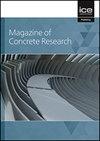Dynamic uniaxial compression mechanical properties of self-compacting rubber concrete subjected to different strain rates
IF 1.6
4区 工程技术
Q3 CONSTRUCTION & BUILDING TECHNOLOGY
引用次数: 0
Abstract
Rubber concrete is a kind of light green building material, which is prepared by mixing rubber powder or rubber crumb into ordinary concrete in a certain proportion and then introducing rubber concrete through vibration-free technology to prepare self-compacting rubber concrete. Uniaxial compression tests were carried out on self-compacting rubber concrete with two particle sizes at different strain rates, and the effects of strain rate and rubber content on the dynamic mechanical properties of self-compacting rubber concrete were studied. The microstructure of self-compacting rubber concrete before and after damage was analyzed. Compared with ordinary concrete, the self-compacting rubber concrete is capable of maintaining good integrity during damage, when the rubber powder content exceeds 10% and the rubber crumb content exceeds 15%. The results indicate that as the strain rate increases, both the peak stress and the elastic modulus increase, indicating the strain rate enhancement effect, while the strain rate effect of the peak strain is not evident. Moreover, the model equations of peak stress and elastic modulus strain rate effect were established, the dynamic damage constitutive model was proposed, the damage evolution was analyzed, and the stress intervals were assigned to the various stages of damage evolution.不同应变率下自密实橡胶混凝土的动态单轴压缩力学性能
橡胶混凝土是一种轻质绿色建材,是将橡胶粉或橡胶屑按一定比例掺入普通混凝土中,通过免振技术引入橡胶混凝土制备而成的自密实橡胶混凝土。对两种粒径的自密实橡胶混凝土进行了不同应变速率下的单轴压缩试验,研究了应变速率和橡胶含量对自密实橡胶混凝土动态力学性能的影响。分析了破坏前后自密实橡胶混凝土的微观结构。与普通混凝土相比,当橡胶粉含量超过 10%、橡胶屑含量超过 15%时,自密实橡胶混凝土在破坏过程中能保持良好的整体性。结果表明,随着应变速率的增加,峰值应力和弹性模量都会增加,说明应变速率有增强效应,而峰值应变的应变速率效应不明显。此外,还建立了峰值应力和弹性模量应变速率效应的模型方程,提出了动态损伤构成模型,分析了损伤演化过程,并为损伤演化的各个阶段分配了应力区间。
本文章由计算机程序翻译,如有差异,请以英文原文为准。
求助全文
约1分钟内获得全文
求助全文
来源期刊

Magazine of Concrete Research
工程技术-材料科学:综合
CiteScore
4.60
自引率
11.10%
发文量
102
审稿时长
5 months
期刊介绍:
For concrete and other cementitious derivatives to be developed further, we need to understand the use of alternative hydraulically active materials used in combination with plain Portland Cement, sustainability and durability issues. Both fundamental and best practice issues need to be addressed.
Magazine of Concrete Research covers every aspect of concrete manufacture and behaviour from performance and evaluation of constituent materials to mix design, testing, durability, structural analysis and composite construction.
 求助内容:
求助内容: 应助结果提醒方式:
应助结果提醒方式:


